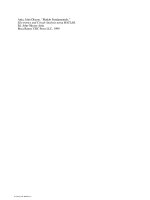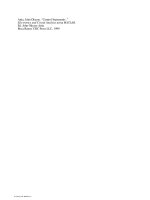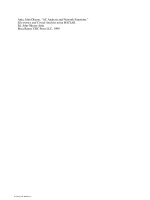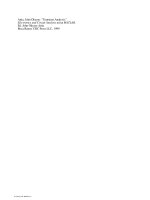Tài liệu Electronics and Circuit Analysis Using MATLAB P12 pdf
Bạn đang xem bản rút gọn của tài liệu. Xem và tải ngay bản đầy đủ của tài liệu tại đây (408.33 KB, 52 trang )
Attia, John Okyere. “Transistor Circuits.”
Electronics and Circuit Analysis using MATLAB.
Ed. John Okyere Attia
Boca Raton: CRC Press LLC, 1999
© 1999 by CRC PRESS LLC
CHAPTER TWELVE
TRANSISTOR CIRCUITS
In this chapter, MATLAB will be used to solve problems involving metal-
oxide semiconductor field effect and bipolar junction transistors. The general
topics to be discussed in this chapter are dc model of BJT and MOSFET,
biasing of discrete and integrated circuits, and frequency response of
amplifiers.
12.1 BIPOLAR JUNCTION TRANSISTORS
Bipolar junction transistor (BJT) consists of two pn junctions connected back-
to-back. The operation of the BJT depends on the flow of both majority and
minority carriers. There are two types of BJT: npn and pnp transistors. The
electronic symbols of the two types of transistors are shown in Figure 12.1.
B
E
C
I
E
I
C
I
B
B
C
I
E
I
C
I
B
(a) (b)
Figure 12.1 (a) NPN transistor (b) PNP Transistor
The dc behavior of the BJT can be described by the Ebers-Moll Model. The
equations for the model are
II
V
V
FES
BE
T
=
−
exp 1
(12.1)
II
V
V
RCS
BC
T
=
−
exp 1
(12.2)
© 1999 CRC Press LLC
© 1999 CRC Press LLC
and
III
CFFR
=−
α
(12.3)
II I
EFRR
=− +
α
(12.4)
and
()()
III
BFFRR
=− +−
11
αα
(12.5)
where
I
ES
and
I
CS
are the base-emitter and base-collector saturation
currents, respectively
α
R
is large signal reverse current gain of a common-base
configuration
α
F
is large signal forward current gain of the common-base
configuration.
and
V
kT
q
T
=
(12.6)
where
k
is the Boltzmann’s constant (
k
= 1.381 x 10
-23
V.C/
o
K ),
T
is the absolute temperature in degrees Kelvin, and
q
is the charge of an electron (q = 1.602 x 10
-19
C).
The forward and reverse current gains are related by the expression
αα
RCS F ES S
III
==
(12.7)
where
I
S
is the BJT transport saturation current.
The parameters
α
R
and
α
F
are influenced by impurity concentrations and
junction depths. The saturation current,
I
S
, can be expressed as
© 1999 CRC Press LLC
© 1999 CRC Press LLC
IJA
SS
=
(12.8)
where
A
is the area of the emitter and
J
S
is the transport saturation current density, and it can be
further expressed as
J
qD n
Q
S
ni
B
=
2
(12.9)
where
D
n
is the average effective electron diffusion constant
n
i
is the intrinsic carrier concentration in silicon (
n
i
= 1.45 x
10
10
atoms / cm
3
at 300
o
K)
Q
B
is the number of doping atoms in the base per unit area.
The dc equivalent circuit of the BJT is based upon the Ebers-Moll model.
The model is shown in Figure 12.2. The current sources
α
RR
I
indicate the
interaction between the base-emitter and base-collector junctions due to the
narrow base region.
In the case of a pnp transistor, the directions of the diodes in Figure 12.2 are
reversed. In addition, the voltage polarities of Equations (12.1) and (12.2) are
reversed. The resulting Ebers-Moll equations for pnp transistors are
II
V
V
EES
EB
T
=
−
exp 1
−
−
α
RCS
CB
T
I
V
V
exp 1
(12.10)
II
V
V
CFES
EB
T
=−
−
α
exp 1
+
−
I
V
V
CS
CB
T
exp 1
(12.11)
© 1999 CRC Press LLC
© 1999 CRC Press LLC
α
I
C
I
E
I
R
I
F
R
I
F
R
I
F
V
BC
V
BE
I
B
α
+
+
-
-
Figure 12.2 Ebers-Moll Static Model for an NPN transistor
(Injection Version)
The voltages at the base-emitter and base-collector junctions will define the
regions of operation. The four regions of operations are forward-active,
reverse-active, saturation and cut-off. Figure 12.3 shows the regions of
operation based on the polarities of the base-emitter and base collector
junctions.
Forward-Active Region
The forward-active region corresponds to forward biasing the emitter-base
junction and reverse biasing the base-collector junction. It is the normal
operational region of transistors employed for amplifications. If
V
BE
> 0.5 V
and
V
BC
< 0.3V, then equations (12.1) to (12.4) and (12.6) can be rewritten
as
II
V
V
CS
BE
T
=
exp
(12.12)
© 1999 CRC Press LLC
© 1999 CRC Press LLC
I
IV
V
E
S
F
BE
T
=−
α
exp
(12.13)
From Figure 12.1,
()
III
BCE
=− +
(12.14)
Substituting Equations (12.12) and (12.13) into (12.14), we have
()
II
V
V
BS
F
F
BE
T
=
−
1
α
α
exp
(12.15)
=
IV
V
S
F
BE
T
β
exp
(12.16)
where
β
F
=
large signal forward current gain of common-emitter
configuration
β
F
=
α
α
F
F
1
−
(12.17)
From Equations (12.12) and (12.16), we have
II
CFB
=
β
(12.18)
We can also define,
β
R
, the large signal reverse current gain of the common-
emitter configuration as
β
α
α
R
R
R
=
−
1
(12.19)
© 1999 CRC Press LLC
© 1999 CRC Press LLC
reverse bias
cut-off
forward bias
reverse-active
V
BC
V
BE
forward-active
reverse bias forward bias
saturation
Figure 12.3 Regions of Operation for a BJT as Defined by the Bias
of
V
BE
and
V
BC
Reverse-Active Region
The reverse-active region corresponds to reverse biasing the emitter-base
junction and forward biasing the base-collector junction. The Ebers-Moll
model in the reverse-active region (
V
BC
> 0.5V and
V
BE
< 0.3V) simplifies to
II
V
V
ES
BC
T
=
(12.20)
I
IV
V
B
S
R
BC
T
=
β
exp
(12.21)
Thus,
II
ERB
=
β
(12.22)
The reverse-active region is seldom used.
© 1999 CRC Press LLC
© 1999 CRC Press LLC
Saturation and Cut-off Regions
The saturation region corresponds to forward biasing both base-emitter and
base-collector junctions. A switching transistor will be in the saturation region
when the device is in the conducting or “ON” state.
The cut-off region corresponds to reverse biasing the base-emitter and base-
collector junctions. The collector and base currents are very small compared
to those that flow when transistors are in the active-forward and saturation
regions. In most applications, it is adequate to assume that
III
CBE
===
0
when a BJT is in the cut-off region. A switching
transistor will be in the cut-off region when the device is not conducting or in
the “OFF” state.
Example 12.1
Assume that a BJT has an emitter area of 5.0 mil
2
,
β
F
=
120,
β
R
=
03.
transport current density,
J
S
=
−
210
10
*
µ
Amil
/
2
and
T
= 300
o
K. Plot
I
E
versus
V
BE
for
V
BC
= -1V. Assume 0 <
V
BE
< 0.7 V.
Solution
From Equations (12.1), (12.2) and (12.4), we can write the following
MATLAB program.
MATLAB Script
%Input characteristics of a BJT
diary ex12_1.dat
diary on
k=1.381e-23; temp=300; q=1.602e-19;
cur_den=2e-10; area=5.0; beta_f=120; beta_r=0.3;
vt=k*temp/q; is=cur_den*area;
alpha_f=beta_f/(1+beta_f);
alpha_r = beta_r/(1+beta_r);
ies=is/alpha_f;
vbe=0.3:0.01:0.65;
ics=is/alpha_r;
m=length(vbe)
for i = 1:m
ifr(i) = ies*exp((vbe(i)/vt)-1);
© 1999 CRC Press LLC
© 1999 CRC Press LLC
ir1(i) = ics*exp((-1.0/vt)-1);
ie1(i) = abs(-ifr(i) + alpha_r*ir1(i));
end
plot(vbe,ie1)
title('Input characteristics')
xlabel('Base-emitter voltage, V')
ylabel('Emitter current, A')
Figure 12.4 shows the input characteristics.
Figure 12.4 Input Characteristics of a Bipolar Junction Transistor
Experimental studies indicate that the collector current of the BJT in the
forward-active region increases linearly with the voltage between the collector-
emitter V
CE
. Equation 12.12 can be modified as
II
V
V
V
V
CS
BE
T
CE
AF
≅
+
exp 1
(12.23)
where
V
AF
is a constant dependent on the fabrication process.
© 1999 CRC Press LLC
© 1999 CRC Press LLC
Example 12.2
For an npn transistor with emitter area of 5.5 mil
2
,
α
F
=
098.,
α
R
=
035.,
VV
AF
=
250
and transport current density is
20 10
9
.
x
−
µ
Amil
/
2
. Use
MATLAB to plot the output characteristic for
V
BE
= 0.65 V. Neglect the
effect of
V
AF
on the output current
I
C
. Assume a temperature of 300
o
K.
Solution
MATLAB Script
%output characteristic of an npn transistor
%
diary ex12_2.dat
k=1.381e-23; temp=300; q=1.602e-19;
cur_den=2.0e-15; area=5.5; alpha_f=0.98;
alpha_r=0.35; vt=k*temp/q; is=cur_den*area;
ies=is/alpha_f; ics=is/alpha_r;
vbe= [0.65];
vce=[0 0.07 0.1 0.2 0.3 0.4 0.5 0.6 0.7 1 2 4 6];
n=length(vbe);
m=length(vce);
for i=1:n
for j=1:m
ifr(i,j)= ies*exp((vbe(i)/vt) - 1);
vbc(j) = vbe(i) - vce(j);
ir(i,j) = ics*exp((vbc(j)/vt) - 1);
ic(i,j) = alpha_f*ifr(i,j) - ir(i,j);
end
end
ic1 = ic(1,:);
plot(vce, ic1,'w')
title('Output Characteristic')
xlabel('Collector-emitter Voltage, V')
ylabel('Collector current, A')
text(3,3.1e-4, 'Vbe = 0.65 V')
axis([0,6,0,4e-4])
Figure 12.5 shows the output characteristic.
© 1999 CRC Press LLC
© 1999 CRC Press LLC
Figure 12.5 Output Characteristic on an NPN Transistor
12.2 BIASING BJT DISCRETE CIRCUITS
12.2.1 Self-bias circuit
One of the most frequently used biasing circuits for discrete transistor circuits
is the self-bias of the emitter-bias circuit shown in Figure 12.6.
V
CC
R
BI
R
C
R
E
R
B2
C
E
(a)
© 1999 CRC Press LLC
© 1999 CRC Press LLC
-
V
CC
R
C
R
E
R
BB
V
BB
V
CE
I
E
I
B
I
C
+
+
-
(b)
Figure 12.6 (a) Self-Bias Circuit (b) DC Equivalent Circuit of (a)
The emitter resistance,
R
E
, provides stabilization of the bias point. If
V
BB
and
R
B
are the Thevenin equivalent parameters for the base bias circuit, then
V
VR
RR
BB
CC B
BB
=
+
2
12
(12.24)
RRR
BBB
=
12
(12.25)
Using Kirchoff’s Voltage Law for the base circuit, we have
VIRVIR
BB B B BE E E
=++
(12.26)
Using Equation (12.18) and Figure 12.6b, we have
()
IIII I I
EBCBFB F B
=+=+ = +
ββ
1
(12.27)
Substituting Equations (12.18) and (12.27) into (12.26), we have
© 1999 CRC Press LLC
© 1999 CRC Press LLC
()
I
VV
RR
B
BB BE
BF E
=
−
++
β
1
(12.28)
or
()
I
VV
R
R
C
BB BE
B
F
F
F
E
=
−
+
+
β
β
β
1
(12.29)
Applying KVL at the output loop of Figure 12.6b gives
VVIRIR
CE CC C C E E
=− −
(12.30)
=− +
VIR
R
CC C C
E
F
α
(12.31)
12.2.2 Bias stability
Equation (12.30) gives the parameters that influence the bias current
I
C
. The
voltage
V
BB
depends on the supply voltage
V
CC
. In some cases,
V
CC
would
vary with
I
C
, but by using a stabilized voltage supply we can ignore the
changes in
V
CC
, and hence
V
BB
.
The changes in the resistances
R
BB
and
R
E
are negligible. There is a variation of
β
F
with respect to changes in
I
C
.
A typical plot of
β
F
versus
I
C
is shown in Figure 12.7.
B
f
________
B
f
max
0.5
1
I
C
Figure 12.7 Normalized plot of
β
F
as a Function of Collector
Current
© 1999 CRC Press LLC
© 1999 CRC Press LLC
Temperature changes cause two transistor parameters to change. These are (1)
base-emitter voltage (
V
BE
) and (2) collector leakage current between the base
and collector (
I
CBO
). The variation on
V
BE
with temperature is similar to
the changes of the pn junction diode voltage with temperature. For silicon
transistors, the voltage
V
BE
varies almost linearly with temperature as
()
∆VTTmV
BE
≅− −
2
21
(12.32)
where
T
1
and
T
2
are in degrees Celsius.
The collector-to-base leakage current,
I
CBO
,
approximately doubles every 10
o
temperature rise. As discussed in Section 9.1, if
I
CBO
1
is the reverse leakage
current at room temperature (25
o
C), then
II
CBO CBO
T
O
C
21
2
2
25 10
=
−
/
and
∆II I I
CBO CBO CBO
=−=
21
=−
−
I
CBO
T
O
C
21
2
25 10/
(12.33)
Since the variations in
I
CBO
and
V
BE
are temperature dependent, but changes
in
V
CC
and
β
F
are due to factors other than temperature, the information
about the changes in
V
CC
and
β
F
must be specified.
From the above discussion, the collector current is a function of four variables:
VI V
BE CBO F CC
,,,.
β
The change in collector current can be obtained using
partial derivatives. For small parameter changes, a change in collector current
is given as
∆∆ ∆ ∆∆
I
I
V
V
I
V
I
II
V
V
C
C
BE
BE
C
CBO
CBO
C
F
F
C
CC
CC
=+ ++
∂
∂
∂
∂
∂
∂β
β
∂
∂
(12.34)
© 1999 CRC Press LLC
© 1999 CRC Press LLC
The stability factors can be defined for the four variables as
S
II
C
F
C
F
β
∂
∂β β
=≅
∆
∆
S
I
V
I
V
v
C
BE
C
BE
=≅
∂
∂
∆
∆
S
I
I
I
I
I
C
CBO
C
CBO
=≅
∂
∂
∆
∆
and
S
I
V
I
V
VCC
C
CC
C
CC
=≅
∂
∂
∆
∆
(12.35)
Using the stability factors, Equation (12.34) becomes
∆∆ ∆∆ ∆ISV S SI SV
C V BE F I CBO VCC CC
=+++
β
β
(12.36)
From Equation (12.30),
S
dI
dV
R
R
V
C
BE
B
F
E
F
F
==−
+
+
1
1
β
β
β
(12.37)
From Equation (12.31),
I
VV
R
R
C
CC CE
C
E
F
=
−
+
α
(12.38)
Thus, the stability factor
S
VCC
is given as
S
dI
dV R R
VCC
C
CC C E F
==
+
1
α
(12.39)
To obtain the stability factor
S
I
,
an expression for
I
C
involving
I
CBO
needs
to be derived. The derivation is assisted by referring to Figure 12.8.
© 1999 CRC Press LLC
© 1999 CRC Press LLC
I
B
I
E
I
c
'
I
C
I
CBO
Figure 12.8 Current in Transistor including
I
CBO
The current
III
CCCBO
=+
'
(12.40)
and
()
III
CFBCBO
'
=+
β
(12.41)
From Equations (12.40) and (12.41), we have
()
II I
CFB F CBO
=++
ββ
1
(12.42)
Assuming that
ββ
FF
+≅
1
, then
III
CFBFCBO
=+
ββ
(12.43)
so
I
I
I
B
C
F
CBO
=−
β
(12.44)
The loop equation of the base-emitter circuit of Figure 12.6(b) gives
()
VV IR RII
BB BE B BB E B C
−= + +
()
=++IR R RI
BBB E EC
(12.45)
© 1999 CRC Press LLC
© 1999 CRC Press LLC
Assuming that
ββ
FF
+≅
1
and substituting Equation (12.44) into (12.45),
we get
()
VV R R
I
IIR
BB BE BB E
C
F
CBO C E
−= + −
+
β
(12.46)
Solving for
I
C
, we have
()
()
I
VV R RI
RR
R
C
BB BE BB E CBO
BB E
F
E
=
−+ +
+
+
β
(12.47)
Taking the partial derivative,
()
S
I
I
RR
RR
R
I
C
CBO
BB E
BB E
F
E
==
+
+
+
∂
∂
β
(12.48)
The stability factor involving
β
F
and
S
β
can also be found by taking the
partial derivative of Equation (12.47). Thus,
() ()
[]
()
S
I
RRV V RRI
RR R
C
B E BB BE B E CBO
BE E
β
∂
∂β
β
==
+−++
++
2
(12.49)
The following example shows the use of MATLAB for finding the changes in
the quiescent point of a transistor due variations in temperature, base-to-
emitter voltage and common emitter current gain.
Example 12.3
The self-bias circuit of Figure 12.6 has the following element values:
RKRKRKRK
BB ECF
12
50 10 12 6 8
====
,,.,.,
β
varies from
150 to 200 and
V
CC
is
10 0 05
±
.
V.
I
CBO
is 1 µA at 25
0
C. Calculate the
collector current at 25
o
C and plot the change in collector current for
temperatures between 25 and 100
o
C. Assume
V
BE
and
β
F
at 25
o
C are 0.7 V
and 150, respectively.
© 1999 CRC Press LLC
© 1999 CRC Press LLC
Solution
Equations (12.25), (12.26), and (12.30) can be used to calculate the collector
current. At each temperature, the stability factors are calculated using
Equations (12.37), (12.39), (12,48) and (12.49). The changes in
V
BE
and
I
CBO
with temperature are obtained using Equations (12.32) and (12.33),
respectively. The change in
I
C
for each temperature is calculated using
Equation (12.36).
MATLAB Script:
% Bias stability
%
rb1=50e3; rb2=10e3; re=1.2e3; rc=6.8e3;
vcc=10; vbe=0.7; icbo25=1e-6; beta=(150+200)/2;
vbb=vcc*rb2/(rb1+rb2);
rb=rb1*rb2/(rb1+rb2);
ic=beta*(vbb-vbe)/(rb+(beta+1)*re);
%stability factors are calculated
svbe=-beta/(rb+(beta+1)*re);
alpha=beta/(beta+1);
svcc=1/(rc + (re/alpha));
svicbo=(rb+re)/(re+(rb+re)/alpha);
sbeta=((rb+re)*(vbb-vbe+icbo25*(rb+re))/(rb+re+beta*re)^2);
% Calculate changes in Ic for various temperatures
t=25:1:100;
len_t = length(t);
dbeta = 50; dvcc=0.1;
for i=1:len_t
dvbe(i)= -2e-3*(t(i)-25);
dicbo(i)=icbo25*(2^((t(i)-25)/10)-1);
dic(i)=svbe*dvbe(i)+svcc*dvcc...
+svicbo+dicbo(i)+sbeta*dbeta;
end
plot(t,dicbo)
title('Change in collector current vs. temperature')
xlabel('Temperature, degree C')
ylabel('Change in collector current, A')
Figure 12.9 shows
I
C
versus temperature.
© 1999 CRC Press LLC
© 1999 CRC Press LLC
Figure 12.9
I
C
versus Temperature
12.3 INTEGRATED CIRCUIT BIASING
Biasing schemes for discrete electronic circuits are not suitable for integrated
circuits (IC) because of the large number of resistors and the large coupling
and bypass capacitor required for biasing discrete electronic circuits. It is
uneconomical to fabricate IC resistors since they take a disproportionately
large area on an IC chip. In addition, it is almost impossible to fabricate IC
inductors. Biasing of ICs is done using mostly transistors that are connected to
create constant current sources. Examples of integrated circuit biasing
schemes are discussed in this section.
© 1999 CRC Press LLC
© 1999 CRC Press LLC
12.3.1 Simple current mirror
A simple current mirror is shown in Figure 12.10. The current mirror consists
of two matched transistors Q
1
and Q
2
with their bases and emitters connected.
The transistor Q
1
is connected as a diode by shorting the base to its collector.
V
CC
I
R
I
C1
Q1 Q2
I
B1
I
B2
R
C
I
O
Figure 12.10 Simple Current Mirror
From Figure 12.10, we observe that
I
VV
R
R
CC BE
C
=
−
(12.50)
Using KCL, we get
IIII
RC B B
=++
112
=+
II
EB
12
(12.51)
But
I
I
B
E
2
2
1
=
+
β
© 1999 CRC Press LLC
© 1999 CRC Press LLC
Assuming matched transistors
II
BB
12
≅
II
EE
12
≅
(12.52)
From Equations (12.51) and (12.52), we get
II
I
II
RE
E
EE
=+
+
≅+
+
=
+
+
1
2
22
1
1
1
1
2
1
ββ
β
β
(12.53)
and
II I
I
OC B
E
== =
+
22
2
1
β
β
β
Therefore
III
ORR
=
+
+
+
=
+
β
β
β
β
β
β
1
1
22
(12.54)
II
OR
≅
if β >> 1 (12.55)
Equation (15.55) is true provided Q
2
is in the active mode. In the latter mode
of transistor operation, the device Q
2
behaves as a current source. For Q
2
to
be in the active mode, the following relation should be satisfied
VV
CE CEsat
2
>
12.3.2 Wilson current source
The Wilson current source, shown in Figure 12.11, achieves high output
resistance and an output current that is less dependent on transistor
β
F
.
To
obtain an expression for the output current, we assume that all three transistors
are identical. Thus
© 1999 CRC Press LLC
© 1999 CRC Press LLC
II
CC
12
=
VV
BE BE
12
=
ββββ
FF F F
123
===
(12.56)
V
CC
I
R
I
C1
Q1 Q2
I
B1
I
B2
R
C
I
O
I
E3
I
E2
Q3
I
B3
Figure 12.11 Wilson Current Source
Using KCL at the collector of transistor Q
3
, we get
IIII
I
CRBR
O
F
13
=− =−
β
therefore,
()
III
OFRC
=−
β
1
(12.57)
Using KCL at the emitter of Q
3
, we obtain
IIIII I
ECBBC B
32121 1
2
=++=+
© 1999 CRC Press LLC
© 1999 CRC Press LLC
=+
I
C
F
1
1
2
β
(12.58)
But
II I
FE
F
F
E
03 3
1
==
+
α
β
β
(12.59)
Substituting Equation (12.58) into (12.59), we have
II
F
FF
C
01
1
1
2
=
+
+
β
ββ
(12.60)
Simplifying Equation (12.60), we get
II
C
F
F
10
1
2
=
+
+
β
β
(12.61)
Combining Equations (12.57) and (12.61), we obtain
II I
FR
F
F
00
1
2
=−
+
+
β
β
β
(12.62)
Simplifying Equation (12.62), we get
II
FF
FF
R
0
2
2
2
22
=
+
++
ββ
ββ
=
1
2
22
2
−
++
ββ
FF
R
I
(12.63)
For reasonable values of
β
F
2
22
1
2
ββ
FF
++
<<
© 1999 CRC Press LLC
© 1999 CRC Press LLC
and Equation (12.63) becomes
II
R
0
≅
Thus,
β
has little effect on the output current, and
I
VV V
R
R
CC BE BE
C
=
−−
31
(12.64)
Example 12.4
For Figures 12.10 and 12.11, what are the percentage difference between the
reference and output currents for the
β
F
from 40 to 200. Assume that for
both figures,
VV
CC
=
10 ,
RK
C
=
50
Ω
and
VV
BE
=
07..
Solution
We use Equation (12.50) to calculate
I
R
and Equation (12.53) to find
I
0
of
the simple current mirror. Similarly, we use Equation (12.64) to find
I
R
and
Equation (12.63) to calculate
I
0
of the Wilson current source.
MATLAB Script
% Integrated circuit Biasing
vcc=10; rc=50e3; vbe=0.7;
beta =40:5:200; ir1=(vcc-vbe)/rc;
ir2=(vcc-2*vbe)/rc; m=length(beta);
for i=1:m
io1(i) = beta(i)*ir1/(beta(i) + 2);
pd1(i)=abs((io1(i)-ir1)*100/ir1);
io2(i)=(beta(i)^2+2*beta(i))/(beta(i)^2+2*beta(i)+2);
pd2(i)=abs((io2(i)*ir2-ir2)*100/ir2);
end
subplot(211), plot(beta,pd1)
%title('error for simple current mirror')
xlabel('Transistor beta')
ylabel('Percentage error')
text(90,5,'Error for simple current mirror')
subplot(212),plot(beta,pd2)
© 1999 CRC Press LLC
© 1999 CRC Press LLC
%title('Error for Wilson current mirror')
xlabel('Transistor beta')
ylabel('Percentage error')
text(90, 0.13, 'Error for Wilson current source')
Figure 12.12 shows the percentage errors obtained for the simple current
mirror and Wilson current source.
Figure 12.12 Percentage Error between Reference and Output
Currents for Simple Current Mirror and Wilson
Current Source
12.4 FREQUENCY RESPONSE OF COMMON EMITTER
AMPLIFIER
The common-emitter amplifier, shown in Figure 12.13, is capable of
generating a relatively high current and voltage gains. The input resistance is
medium and is essentially independent of the load resistance
R
L
.
The output
resistance is relatively high and is essentially independent of the source
resistance.
© 1999 CRC Press LLC
© 1999 CRC Press LLC









